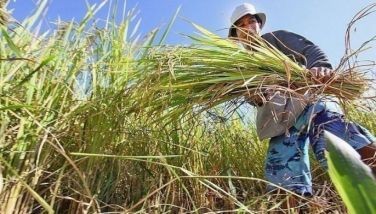PhilRice develops 3-in-1 rice
Tremendous benefits are anticipated in a three-in-one rice variety that is now being developed by the Philippine Rice Research Institute (PhilRice) even as its commercial production is expected to start four years from now.
Breeding work started in 2004 soon after PhilRice received genetically modified Golden Rice events donated by the Gates Foundation. Field tests on the grains that have been developed will begin before the end of 2008.
Golden Rice is the result of genetic engineering that involved the deliberate introduction of two genes from other organisms. The process completed the biochemical pathway that allows beta-carotene production in rice grains, giving them the distinct yellow color.
The three-in-one rice will be the first of its kind, as it will contain three important traits never before found at the same time in a rice variety, said PhilRice scientist Dr. Antonio A. Alfonso who leads the breeding team. Through conventional breeding techniques, genes for beta-carotene biosynthesis from Golden Rice as well as rice tungro disease and bacterial leaf blight resistance are being transferred into the grains of local varieties.
The rice plant produces beta-carotene in its leaves and stems, but none in its grains. Thus, a rice-based diet contributes to high prevalence of vitamin A deficiency or VAD among the poor, who cannot afford to include vegetables, meat, and other foods rich in vitamin A in their meals on a daily basis. Vitamin A, an antioxidant, promotes good vision, enables proper reproduction and lactation among women, and helps in the formation and maintenance of healthy teeth, skeletal and soft tissue, mucuous membrane, and skin.
“Insufficient vitamin A and beta-carotene intake for long periods of time results in morbidity and mortality, particularly among children and pregnant and lactating women – the most affected population groups,” said a research team from the Sikap/Strive Foundation and PhilRice, who conducted an “Ex-Ante Impact Evaluation of Three-in-One Rice.”
VAD may eventually lead to night blindness, Bitot’s spot, corneal ulceration, and corneal scars. If left untreated, corneal ulceration and corneal scars may lead to permanent blindness. It also weakens the immune system, resulting in infections like HIV-AIDS, diarrhea, and measles.
“All these VAD-related diseases, in turn, translate into increased health care costs and economic losses accruing years foregone and loss of potential productivity. But more than the economic costs, the VAD problem deprives those [affected] individuals … of the basic right to an adequately healthy and active life,” reported the research team led by Dr. Leonardo Gonzales.
In the Philippines, 71 percent of total households do not meet their recommended vitamin A (retinol equivalent) nutrients, a recent survey showed. It is not also surprising that four out of 10 children, six months to five years old, suffer from VAD since two of every 10 pregnant and lactating Filipino mothers suffer from VAD.
It is expected that losses from tungro, which reached P10.6 million in 1993, and bacterial leaf blight will be greatly minimized. It was estimated that 8.1 percent of the total area planted to rice can be possibly affected by bacterial leaf blight, and the resulting yield loss could mean about $57.5 million worth of foregone production.
Resistance to rice tungro disease and bacterial leaf blight are being incorporated into the three-in-one rice because these devastating diseases recurrently plague the country.
Both farmers and consumers are expected to benefit from three-in-one rice. The profitability of farmers is expected to increase through reduced costs and higher yields, consumers will be provided with higher levels of micronutrients, thereby boosting their health.
The team estimated that the costs of research and development (R&D) and commercialization, P149 million in 2005 prices, would be outweighed by a net present value (NPV) of P309 million under very low adoption rate.
Under high adoption rate, it will generate an NPV of P1.22 billion with 63 percent IRR. In addition, it could generate health impacts similar to the projected impact of Golden Rice in the Philippines, which is worth an estimated $16-88 million.
- Latest




























